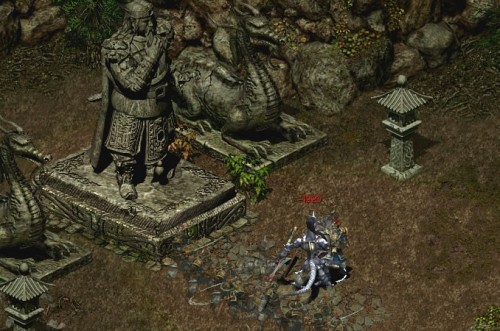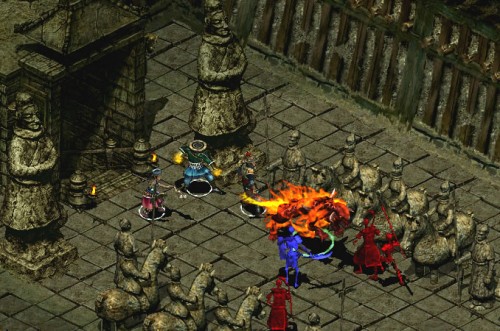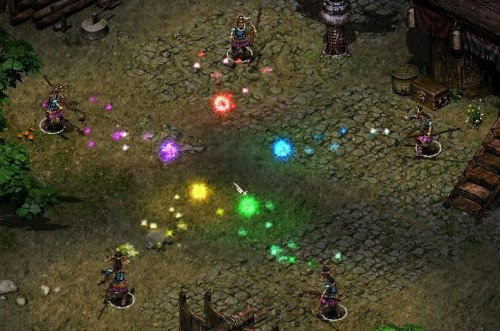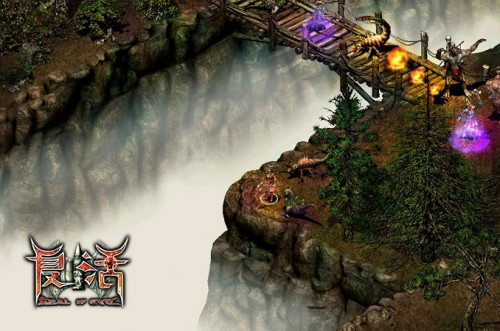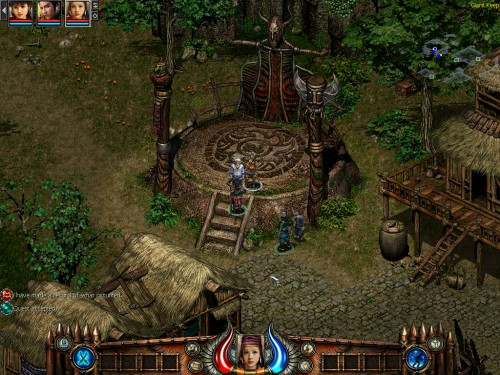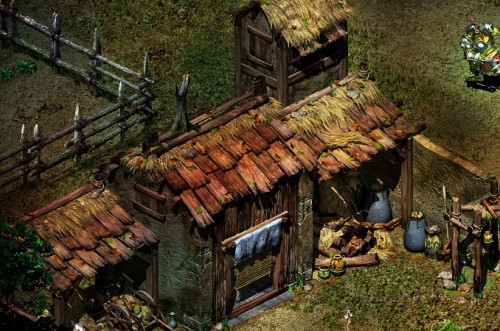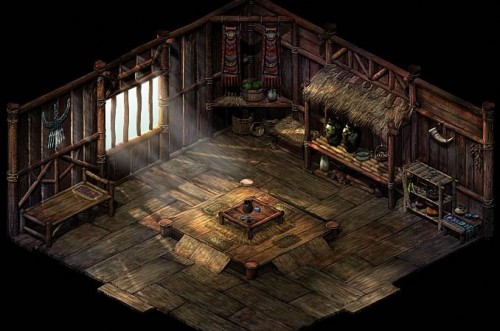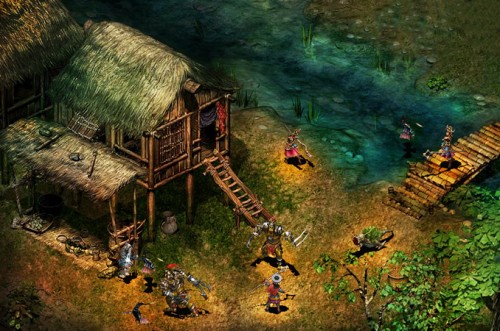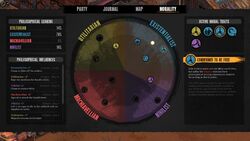Seal of Evil Reviewed
Seal of Evil Reviewed
Codex Review - posted by Exitium on Sun 30 January 2005, 16:54:21
Tags: Object Software; Seal of EvilWe've all been waiting for the next fun RPG to load up and play to our hearts content on our computers. Needless to say, it's been a long time coming. In my hands, I hold a copy of Object Software's latest foray into the RPG genre, Seal of Evil. Does Seal of Evil fulfill the role of the much needed boost of life to a currently lifeless RPG playfield? Read on and find out.
Seal of Evil is a classic RPG set in the theme of ancient China, with a few fantasy twists, much of which derives from cultural mythology of the aforementioned period and region. Seal of Evil weaves a tale of hardship and strife set within the twilight years of the Warring States Period of Chinese history, which occurred over the years between 476 and 206 BC, prior to the foundation of a unified Middle Kingdom, or China by the Qin Empire. As the manual states,
This turbulent time marks the disintegration of the longest-lived of all imperial dynasties, the Zhou. Out of the strife and chaos emerges a nobleman possessed of an indomitable spirit and an uncompromising vision of the future: Ying Zheng, ruler of the Qin state. He will stop at nothing to reunite the disparate Chinese kingdoms.
Ying Zheng, later known as the August Emperor, Qin Shihuang, was the King of the illustrious Qin state. At the time of Prince Zheng's birth, China was divided into a milieu of warring feudal states. The competition was extremely fierce and by 259 BCE there were few states left (the others having been conquered and annexed), but Zheng's state, Qin, was the most powerful. When Zheng ascended the throne in 246 BCE and continued the tradition of tenaciously attacking and defeating the feudal states (dodging a celebrated assassination attempt by Jing Ke while doing so) and finally took control of all China in 221 BCE.
Much like its predecessor, Prince of Qin, which was released in 2002, Seal of Evil combines ancient legends and mythic storytelling with historical fact. The story of Seal of Evil is set in the last few years of the Warring States period in ancient China, roughly 15 years before Prince of Qin takes place. During this time, Qin had gradually become the most powerful state in China and began making an overall plan to conquer the other six states. Meanwhile, Qin troops kept attacking the Baiyue people living in the southwest of China. As a result of these repeated invasions the whole race of West Baiyue led by Yan Bo was annihilated. The people of East Baiyue, under the leadership of Lan Xiong, then fought a desperate war against the Qin army.
Seal of Evil puts you in the shoes of Lan Wei, the daughter of Lan Xiong, the Chieftain of East Baiyue who along with the Chief Sacrifice Wizard, Chi Huan, die mysteriously at the beginning of the game. Aided by her boy friend Yan Hong and a Beastman friend named Liang Hu, our protagonists begin their dangerous adventure into the Central Plains to find the famous Empyrean Stones which Lan Wei believed could be used, by piecing them together, to make her father live again, and thwart the Qin invasion of their peaceful homeland.
The first thing to note is that the story is quite fleshed out, and your immersion into the setting is greatly aided by historical record. There is, however, a very distinct lack of character creation which may come as a minus, but there is plenty of character development and customization where that is concerned that can almost make up for this shortcoming given the wide range of options you have in equipment combinations, sets, attribute distribution and skill selection.
While you initially control only Lan Wei, a witch, and Liang Hu who is a beastman, which is the equivalent of a Muscleman in Seal of Evil's predecessor, Prince of Qin, more characters including a wizard, an assassin and finally a grizzled Paladin will join your intrepid adventures throughout the game. One thing of note is that only three characters may participate with you in combat at any given time, though all of them will travel with you and will appear in many of the game's cutscenes that serve to drive the game's narrative.
Each of the five characters has at their disposal a unique set of skills that serve to differentiate them from one another, not only in name, but also in utility. As stated, the five heroes each have unique skills that apply strictly to their chosen professions so no skill is alike. Like its predecessor, Prince of Qin, all of these skills are combat related and serve a variety of purposes, including offense, defense, buffs, and support. These skills add a strong dimension to strategy and tactics.
In addition to normal skill advancement through the accumulation of experience, skills can be improved with elemental attributes or with magical equipment. There are many ways to learn new skills in Seal of Evil, such as by finding a rare scroll in a secret cave, or from kung fu masters.
Lan Wei the Teenage Witch
Lan Wei grew up in the remote Rosy-Cloud Village. Like other clan members, she was born to be simple and kind. Lan Wei was cleverer than other children of her age and she mastered new knowledge very quickly. Because of this, she didn't like to spend much time and energy to practise. She always loafed around and acted like a child. Her father was very strict with her, but she could always seem to escape punishment. People always spoiled her and this made her more unruly and difficult to control. She always made quick decisions without full consideration and often played practical jokes. Each time when she learned magic, she would experiment with it on her friend, Ah Wa. Her father always scolded her about this. When she was young, she was always told how bad the people of the Central Plains were. Her mother died very early because of the invasion of the Qin troops. But she never saw the people of the Central Plains for herself. So she didn't hate the people of the Central Plains as much as her fellow clan members did.
Lan Wei is proficient at casting arcane spells and performing arcane dances to activate the Five-element magic to which she has well attuned herself, Wood and Fire. She is also apt at casting curses at enemies that serve to immobilize and weaken any opposition she encounters. These curses are activated as she enhances her repertoire of magic through the use of equipment belonging to certain elements. Many of the skills and spells in Seal of Evil may be enhanced in this very manner, so your choice of equipment is just as important as the spells which you may choose to use. Fire magic has powerful attack and may be increased with speed-related enhancements with the equipping of Fire element attuned weapons. Likewise, Wood magic brings about some 'debuff' or disadvantageous effects to enemies such as immobility and poison, on top of raw damage. Some powerful curses can even nullify the threat of enemies instantaneously.
The Wizard's Protégé
Yan Hong's father, Yan Bo, was the chief of the West Baiyue. When the Qin army invaded, Yan Bo commanded his fellow people and fought a desperate battle with the invaders. Finally, he died and his race was annihilated. Yan Peng, who was regarded as the traitor of West Baiyue, rescued his nephew Yan Hong at that critical moment and later taught him the skill of summoning beasts. Yan Hong then wandered from place to place accompanying his uncle.
When the Qin army was surrounding Lan Xiong, Yan Bo and Yan Hong helped him. Afterwards, Yan Peng left his nephew to Lan Xiong's care. Lan Xiong then regarded Yan Hong as his pupil and thus Yan Hong stayed and lived in Rosy-Cloud Village. Yan Hong was as kind as his fellow people. His experience made him love his relatives and race very much and hate the Qin people with passion.
His wandering experience during his childhood turned Yan Hong into a reticent and arrogant man. The suffering made him stubborn and persevering. Yan Hong should have been a sensitive person. He was warm-hearted just like Lan Wei, but he was afraid of being hurt again. So he always shied away from communicating with others. Only Lan Wei could understand him and his heart would be open only for Lan Wei.
Yan Hong is a sacrifice wizard, and the protégé to the Chief Sacrifice Wizard Chi Huan. As the manual describes, a wizard is a bridge linked with the gods or in other words — a cleric. Like his misfortunate predecessor, Yan Hong can make use of the power of the gods to bestow spiritual blessing upon other members of his party as well as himself. The power that he wields can not only be used to aid others in the form of buffs, but he can also summon ancient monsters to aid the party to battle against foes. Unlike the Witch, Yan Hong has very low physical attack power, but his supplementary and healing magic play an indispensable role in any combat party.
The Powerful Beast
Liang Hu was relatively weak and small in build as compared to other beastman children. In the race of Beastman that glorified strength, he was always belittled by his clansmen. Liang Hu was emulous since he was a child. Once he made a bet with others and they agreed that the loser would jump from a cliff. After he realized he had lost the bet, he really jumped from the cliff. Thanks to Beastman's incredible endurance and vitality, he survived and wandered in the area of the Central Plains. He was greatly discriminated against there because of his unusual appearance.
When he went to Rosy-Cloud Village, the local people didn't reject him just because of his weird appearance. Lan Wei even regarded him as her blood brother. So he stayed and lived on in Rosy-Cloud Village. He always protected Lan Wei as if she were his blood sister. Although he was a man of few words, the few words he did speak could clearly demonstrate his concern for Lan Wei.
Liang Hu is a beastman, who comes from a group of intelligent, yet monstrous humanoids who live in the high reaches of Heaven's Summit. Like all others of his kind, he lacks agility, but his strength and ability to take a beating is incredible. Like his brethren, he is also able to hurl large boulders as a form of medium-range attack and rain chaos down upon enemy combatants. However, his beast nature is unpredictable and may drive him into a frenzy, which will make Liang Hu become extremely powerful for a short period of time amidst his rage. Hardy and strong, Liang Hu always plays the role of shield in combat, drawing the attention of enemies so that his party members can have time to cast powerful spells and dispatch them in relative safety.
The Unbiased Assassin
Cai Xin's father was previously a common civilian of the Qin state. He was wounded by accident during a battle and was saved by Cai Lian. Later they fell in love with each other and got married. The fellow villagers opposed this marriage and the couple was separated. Her father wasn't able to contact her after the separation and her mother died of disease a few years later. Cai Xin grew up in an environment of prejudice and distrust. Cai Xin lived in Giant-Monster Village that was very near to the border of the Central Plains. The day before Lan Wei came to her village, the Qin army had begun attacking it. Cai Xin and Lan Wei joined forces to defeat the Qin army. Afterwards, she decided to join Lan Wei's party and hoped to find out where her father was.
Her kindness was derived from her mother and Aunt Ju. She didn't agree with the prejudiced attitude of Yan Hong and Lan Wei towards the people of the Central Plains. But she didn't argue this issue directly with them. She just persuaded them with patient reasoning and logic to help them understand the basic goodness of human nature.
Cai Xin is a young assassin. She is greatly concerned about her weapons and in combat, wields two daggers. Unlike any of the other characters, she has the special ability to combine different kinds of attack skills to create various new skills in the form of combo moves. It is through this manner that she can easily achieve the maximum power of her weapons, utilizing a myriad of different attack skills in unison. Because of her small size, and petite build, Cai Xin can only use light weapons and short blades like daggers and short swords. This in no way reduces her potency as a deadly fighter. With dexterity and quickness of both mind and body, she can deliver deadly damage to her enemies from any angle in quick succession.
The Vengeful Paladin
Gai Nie led a reclusive life in Yuci. He had followed Li Mu, a Great General of the Zhao State, to fight against the Qin army. The Qin army was superior at the time, but they couldn't defeat Zhao easily because of Li Mu. Gai Nie risked his life to fight together with Li Mu. To everyone's surprise, the King of Zhao believed wild rumors about Li Mu's loyalty and had him killed. As a result, Zhao was soon annihilated by Qin. The death of Li Mu made Gai Nie greatly depressed. So he escaped to Yuci with his wife.
Before long, he received a letter from Jing Ke inviting him to join him in a plot to assassinate the King of Qin, Ying Zheng. He hesitated because his wife was pregnant at the time. His wife then persuaded him to kill the ruthless King and he finally decided to join Jing Ke in the assassination plot. Suddenly, a troop of Qin soldiers found their place and killed his wife. At the critical moment, Lan Wei and her companions passed by and saved him. Thanks to the encouragement of Lan Wei and her companions, Gai Nie then joined them to search for the Empyrean Stones.
At last, but not least, is the Chinese Paladin Gai Nie. He is a Paladin of renown, and is expert in the art of swordsmanship. As the manual states, his balanced build and straight swords display a harmonious sense of masculine power. Paladins make good use of the energy cycle and activate their own potential power. His build is balanced over the output of offensive damage and defensive stances. This way they can achieve both a high level of attack and defense. During the Warring States period, paladins were heavily influenced by Mohist philosophy, this by definition means they place a very strong emphasis on teamwork as well as individual improvement, so in addition to being a strong fighter, Gai Nie knows has at his disposal many supplementary skills, in the form of auras, to boost the abilities of his party.
Though unlike Fallout, Seal of Evil is linear in its entirety. It's not too bad, though, as Seal of Evil features a multitude of possible endings, which are determined by your choices and actions while performing certain quests. Similar to KOTOR2, quite often once you've said something, you can't take it back, so be careful what you say, as it may affect the outcome of the quest, if not the entire game.
In addition to the main plot, there's a ton of optional quests along the way that serve to unlock new skills and make them available to your characters, on top of advancing their experience and levels, so it pays to be inquisitive. Some of the quests that you'll encounter in the game consist of multiple parts, plenty of which offer multiple solutions yielding different outcomes.
However as previously stated, the game suffers from linearity. Many of quests in the game take place locally, rather than globally, so if you leave an area before you've completed those quests, they will be rendered as failures in your Quest log. My understanding is that some of these quests take place under a limited time frame, so traveling over a long distance, to a new area, (which logically takes time) is the equivalent of failing them. It's still very irritating, though, and causes an unnecessary reload should you do it by accident. So you have to remember to save often unless you wish to redo some areas by loading from an old save, which isn't a good thing. While the game suffers a lot from its linearity, it certainly doesn't suffer from any lack of variety. There are a wide variety of quests in the game, more than half of which revolve around dialogue options, and not on package deliveries or killing quests, so the game feels interesting throughout.
Like most other RPGs, Seal of Evil has a Quest log to record the quests you choose to accept or reject, succeed or fail. The Travel log records significant events and conversations and often, the completion of certain quests will yield the reward of a detailed history pertaining to the character, situation or place that you dealt with true historical accuracy. There's plenty ‘moral of the story' type of situations that not only serve to educate you with Chinese philosophical wisdom but also practical wisdom. This little detail was present in the original Prince of Qin and served as a nice immersion factor.
There is a complicated interplay between the five elements that not only determine their effectiveness against opposing elements, but also support:
Metal promotes Water,
Water promotes Wood,
Wood promotes Fire,
Fire promotes Earth,
Earth promotes Metal;
Metal restricts Wood,
Wood restricts Earth,
Earth restricts Water,
Water restricts Fire,
Fire restricts Metal.
The theory of the five elements reflects the traditional knowledge of ancient Chinese people towards the world and vividly describes the constitution of the world and defines their very understanding of the world's hidden mechanisms. As I previously stated, the Five-element philosophy is applied throughout the whole game, everything from the character's attributes, skills, equipment, crafting (making-things) to any puzzles you encounter in the game. Having an understanding for the Five-element philosophy and putting that knowledge to use can allow you to achieve interesting results and even unlock bonuses hidden in your items, by awakening their full potential.
Seal of Evil's combat is based in real time, similar to Baldur's Gate and Diablo 2. Like Baldur's Gate, you can pause the game during combat, and like Diablo 2, you can assign one skill to your left mouse button, and an alternative skill to your right mouse button. You may control all three characters at a time, though it is preferable to only be in control of one at a time, as the other two characters will follow the character you are in control of and initiate combat with any enemies you encounter. Unlike the two aforementioned games, you can right click any number of skills on the alt-button to select skills for them to automatically cast when you are not in control of them. Because your NPCs are equipped with good AI, they will know to heal members of the party who are low on health, cast buffs when they need to, and summon monsters to aid the party. They will only do this during combat, so you don't have to worry about expending your mana reserves, which regenerate quickly depending on how much skill you have invested in your character's Water element.
A specially designed monster AI system makes the game play more interesting due to some of the advanced tactics that the enemies you encounter know how to utilize. Enemies know how to support each other in battle as long as they are in sight range of each other. Some skills such as Suicide Bombing and Curse demand high skill in character manipulation. If you don't pay attention to what your characters are doing, you will find yourself in serious trouble. This is different from the hands-off approach taken by games like Neverwinter Nights and Dungeon Siege, of which most players are familiar with. Attacking an enemy from the back will cause more damage than attacking an enemy from the front, thus it will be worth spending some time to consider tactics before fighting and you should always be ready to shift your tactics where necessary. However, it should be noted that you may feel like a spectator in the early part of the game. As you progress, the battles become more challenging and require much more of your input. By then, you'll have figured out which skills to use and how to properly control your characters, so just think of it as an initiation phase.
Each of your characters has an ‘ultimate' ability that they can use when their Rage bar is fully charged. Your rage bar charges as you attack enemies and inflict damage upon them. When it is fully charged, you can use an ability that will unleash devastating effects, some of which may affect the entire screen. You will want to reserve these special abilities until you need them the most. It really helps to save these for the boss fights or gigantic swarms of monsters at some points in the game.
When a character dies in combat, it won't result in a game over screen. He or she will just unavailable until after you've killed off the monsters you were engaging or leave the area.
Speaking of leaving the area, if you leave a ‘wilderness' (e.g. non-town) area and return, it will be repopulated with monsters. This isn't really a big deal, because there's usually little reason to go back to areas you've already been in unless you didn't explore it thoroughly while you were in the area. What this does mean, though, is that you can hunt for raw materials used in item creation to your hearts desire.
In order to create items, you have to acquire raw materials first, which can then be used to create brand new items or upgrade preexisting items. As the manual plainly states, raw materials for item creation can be harvested or found in the wild, bought and traded from merchants or commoners, or taken from enemies slain in combat. In addition to that, you can also acquire especially rare raw materials as rewards from quests, or from chests. Preexisting equipment can also be upgraded by means of the item creation system. Doing so grants enhanced attributes that go beyond the gear's innate attributes. In addition to crafting equipment, items such as medicines and refined gems can also be created and harnessed to your pleasure.
There is plenty of experimentation to be had with the game's advanced item creation system. Different materials yield different results. Item creation can prove to be a very absorbing, if not rewarding time sink.
One of its shortcomings is that the game only supports the resolutions of 800x600 and 1024x768, which is the standard resolution of most mid-range monitors, though those of us with 19" or larger monitors may find this rather dismaying. Thankfully, the game can be played in Windowed mode, but you will have to set your desktop resolution to 16bit in order to do this. It's a minor niggle, but the game looks better on higher resolution monitors that way.
The spell effects are especially excellent to look at. Each skill has its own distinctive look and the 'ultimate' powers of each character can be truly nice to look at. Its look matches the damage you'll be causing with it.
Seal of Evil has an automap that you'll find on the upper right side of your screen that works similarly to one featured in Diablo 2 and Beyond Divinity. While the automap suffices as a combat map, it isn't very useful for tracking your location on a larger scale. It isn't really an issue, though, because the areas in the game are all fairly easy to navigate. You won't be getting lost anytime soon. Seal of Evil also lacks the useful World Map that was present in its predecessor Prince of Qin. I posed this very question to the developer, Liu Gang, and his reasoning is this:
The game's music fares much better than the voiceovers, with traditional Mandarin orchestrations as well as Chinese-themed electronic music. The music's may grow to be a bit repetitive after a hundred plays, but it's still nice to listen to. Unfortunately, there is no separate slider for music and voice, so you'll have to turn it off completely if you want to disable the voices if you have only the English voiceovers. Personally, I don't mind this, because I just listen to MP3s in the background while playing most games, anyhow. All of the spoken dialogue in the game appears on screen in text, so you won't miss anything if you opt to disable the audio.
An Introduction to the Setting
Seal of Evil is a classic RPG set in the theme of ancient China, with a few fantasy twists, much of which derives from cultural mythology of the aforementioned period and region. Seal of Evil weaves a tale of hardship and strife set within the twilight years of the Warring States Period of Chinese history, which occurred over the years between 476 and 206 BC, prior to the foundation of a unified Middle Kingdom, or China by the Qin Empire. As the manual states,
This turbulent time marks the disintegration of the longest-lived of all imperial dynasties, the Zhou. Out of the strife and chaos emerges a nobleman possessed of an indomitable spirit and an uncompromising vision of the future: Ying Zheng, ruler of the Qin state. He will stop at nothing to reunite the disparate Chinese kingdoms.
Ying Zheng, later known as the August Emperor, Qin Shihuang, was the King of the illustrious Qin state. At the time of Prince Zheng's birth, China was divided into a milieu of warring feudal states. The competition was extremely fierce and by 259 BCE there were few states left (the others having been conquered and annexed), but Zheng's state, Qin, was the most powerful. When Zheng ascended the throne in 246 BCE and continued the tradition of tenaciously attacking and defeating the feudal states (dodging a celebrated assassination attempt by Jing Ke while doing so) and finally took control of all China in 221 BCE.
Much like its predecessor, Prince of Qin, which was released in 2002, Seal of Evil combines ancient legends and mythic storytelling with historical fact. The story of Seal of Evil is set in the last few years of the Warring States period in ancient China, roughly 15 years before Prince of Qin takes place. During this time, Qin had gradually become the most powerful state in China and began making an overall plan to conquer the other six states. Meanwhile, Qin troops kept attacking the Baiyue people living in the southwest of China. As a result of these repeated invasions the whole race of West Baiyue led by Yan Bo was annihilated. The people of East Baiyue, under the leadership of Lan Xiong, then fought a desperate war against the Qin army.
Seal of Evil puts you in the shoes of Lan Wei, the daughter of Lan Xiong, the Chieftain of East Baiyue who along with the Chief Sacrifice Wizard, Chi Huan, die mysteriously at the beginning of the game. Aided by her boy friend Yan Hong and a Beastman friend named Liang Hu, our protagonists begin their dangerous adventure into the Central Plains to find the famous Empyrean Stones which Lan Wei believed could be used, by piecing them together, to make her father live again, and thwart the Qin invasion of their peaceful homeland.
Who Are You?
The first thing to note is that the story is quite fleshed out, and your immersion into the setting is greatly aided by historical record. There is, however, a very distinct lack of character creation which may come as a minus, but there is plenty of character development and customization where that is concerned that can almost make up for this shortcoming given the wide range of options you have in equipment combinations, sets, attribute distribution and skill selection.
While you initially control only Lan Wei, a witch, and Liang Hu who is a beastman, which is the equivalent of a Muscleman in Seal of Evil's predecessor, Prince of Qin, more characters including a wizard, an assassin and finally a grizzled Paladin will join your intrepid adventures throughout the game. One thing of note is that only three characters may participate with you in combat at any given time, though all of them will travel with you and will appear in many of the game's cutscenes that serve to drive the game's narrative.
Each of the five characters has at their disposal a unique set of skills that serve to differentiate them from one another, not only in name, but also in utility. As stated, the five heroes each have unique skills that apply strictly to their chosen professions so no skill is alike. Like its predecessor, Prince of Qin, all of these skills are combat related and serve a variety of purposes, including offense, defense, buffs, and support. These skills add a strong dimension to strategy and tactics.
In addition to normal skill advancement through the accumulation of experience, skills can be improved with elemental attributes or with magical equipment. There are many ways to learn new skills in Seal of Evil, such as by finding a rare scroll in a secret cave, or from kung fu masters.
Lan Wei the Teenage Witch
Lan Wei grew up in the remote Rosy-Cloud Village. Like other clan members, she was born to be simple and kind. Lan Wei was cleverer than other children of her age and she mastered new knowledge very quickly. Because of this, she didn't like to spend much time and energy to practise. She always loafed around and acted like a child. Her father was very strict with her, but she could always seem to escape punishment. People always spoiled her and this made her more unruly and difficult to control. She always made quick decisions without full consideration and often played practical jokes. Each time when she learned magic, she would experiment with it on her friend, Ah Wa. Her father always scolded her about this. When she was young, she was always told how bad the people of the Central Plains were. Her mother died very early because of the invasion of the Qin troops. But she never saw the people of the Central Plains for herself. So she didn't hate the people of the Central Plains as much as her fellow clan members did.
The Wizard's Protégé
Yan Hong's father, Yan Bo, was the chief of the West Baiyue. When the Qin army invaded, Yan Bo commanded his fellow people and fought a desperate battle with the invaders. Finally, he died and his race was annihilated. Yan Peng, who was regarded as the traitor of West Baiyue, rescued his nephew Yan Hong at that critical moment and later taught him the skill of summoning beasts. Yan Hong then wandered from place to place accompanying his uncle.
When the Qin army was surrounding Lan Xiong, Yan Bo and Yan Hong helped him. Afterwards, Yan Peng left his nephew to Lan Xiong's care. Lan Xiong then regarded Yan Hong as his pupil and thus Yan Hong stayed and lived in Rosy-Cloud Village. Yan Hong was as kind as his fellow people. His experience made him love his relatives and race very much and hate the Qin people with passion.
His wandering experience during his childhood turned Yan Hong into a reticent and arrogant man. The suffering made him stubborn and persevering. Yan Hong should have been a sensitive person. He was warm-hearted just like Lan Wei, but he was afraid of being hurt again. So he always shied away from communicating with others. Only Lan Wei could understand him and his heart would be open only for Lan Wei.
The Powerful Beast
Liang Hu was relatively weak and small in build as compared to other beastman children. In the race of Beastman that glorified strength, he was always belittled by his clansmen. Liang Hu was emulous since he was a child. Once he made a bet with others and they agreed that the loser would jump from a cliff. After he realized he had lost the bet, he really jumped from the cliff. Thanks to Beastman's incredible endurance and vitality, he survived and wandered in the area of the Central Plains. He was greatly discriminated against there because of his unusual appearance.
When he went to Rosy-Cloud Village, the local people didn't reject him just because of his weird appearance. Lan Wei even regarded him as her blood brother. So he stayed and lived on in Rosy-Cloud Village. He always protected Lan Wei as if she were his blood sister. Although he was a man of few words, the few words he did speak could clearly demonstrate his concern for Lan Wei.
The Unbiased Assassin
Cai Xin's father was previously a common civilian of the Qin state. He was wounded by accident during a battle and was saved by Cai Lian. Later they fell in love with each other and got married. The fellow villagers opposed this marriage and the couple was separated. Her father wasn't able to contact her after the separation and her mother died of disease a few years later. Cai Xin grew up in an environment of prejudice and distrust. Cai Xin lived in Giant-Monster Village that was very near to the border of the Central Plains. The day before Lan Wei came to her village, the Qin army had begun attacking it. Cai Xin and Lan Wei joined forces to defeat the Qin army. Afterwards, she decided to join Lan Wei's party and hoped to find out where her father was.
Her kindness was derived from her mother and Aunt Ju. She didn't agree with the prejudiced attitude of Yan Hong and Lan Wei towards the people of the Central Plains. But she didn't argue this issue directly with them. She just persuaded them with patient reasoning and logic to help them understand the basic goodness of human nature.
The Vengeful Paladin
Gai Nie led a reclusive life in Yuci. He had followed Li Mu, a Great General of the Zhao State, to fight against the Qin army. The Qin army was superior at the time, but they couldn't defeat Zhao easily because of Li Mu. Gai Nie risked his life to fight together with Li Mu. To everyone's surprise, the King of Zhao believed wild rumors about Li Mu's loyalty and had him killed. As a result, Zhao was soon annihilated by Qin. The death of Li Mu made Gai Nie greatly depressed. So he escaped to Yuci with his wife.
Before long, he received a letter from Jing Ke inviting him to join him in a plot to assassinate the King of Qin, Ying Zheng. He hesitated because his wife was pregnant at the time. His wife then persuaded him to kill the ruthless King and he finally decided to join Jing Ke in the assassination plot. Suddenly, a troop of Qin soldiers found their place and killed his wife. At the critical moment, Lan Wei and her companions passed by and saved him. Thanks to the encouragement of Lan Wei and her companions, Gai Nie then joined them to search for the Empyrean Stones.
The Adventure
The game has a simple premise. You are to travel the land in search of the Five Empyrian Stones which will help you to defeat the King of Qin and drive the Qin out of Baiyue lands. Without spoiling too much, I can state that the game's storyline is more complex than it sounds. Fallout started with the premise that you were to go out in search of the Water Chip for Vault 13, and return in no longer than an estimated 150 days time. Simple? Not so. Seal of Evil has its share of similarly interesting plots.Though unlike Fallout, Seal of Evil is linear in its entirety. It's not too bad, though, as Seal of Evil features a multitude of possible endings, which are determined by your choices and actions while performing certain quests. Similar to KOTOR2, quite often once you've said something, you can't take it back, so be careful what you say, as it may affect the outcome of the quest, if not the entire game.
In addition to the main plot, there's a ton of optional quests along the way that serve to unlock new skills and make them available to your characters, on top of advancing their experience and levels, so it pays to be inquisitive. Some of the quests that you'll encounter in the game consist of multiple parts, plenty of which offer multiple solutions yielding different outcomes.
However as previously stated, the game suffers from linearity. Many of quests in the game take place locally, rather than globally, so if you leave an area before you've completed those quests, they will be rendered as failures in your Quest log. My understanding is that some of these quests take place under a limited time frame, so traveling over a long distance, to a new area, (which logically takes time) is the equivalent of failing them. It's still very irritating, though, and causes an unnecessary reload should you do it by accident. So you have to remember to save often unless you wish to redo some areas by loading from an old save, which isn't a good thing. While the game suffers a lot from its linearity, it certainly doesn't suffer from any lack of variety. There are a wide variety of quests in the game, more than half of which revolve around dialogue options, and not on package deliveries or killing quests, so the game feels interesting throughout.
Like most other RPGs, Seal of Evil has a Quest log to record the quests you choose to accept or reject, succeed or fail. The Travel log records significant events and conversations and often, the completion of certain quests will yield the reward of a detailed history pertaining to the character, situation or place that you dealt with true historical accuracy. There's plenty ‘moral of the story' type of situations that not only serve to educate you with Chinese philosophical wisdom but also practical wisdom. This little detail was present in the original Prince of Qin and served as a nice immersion factor.
The Five Element Philosophy
The concept of Five Elements is an outcome of yin and yang interactions. The five elements are Metal, Wood, Water, Fire and Earth. Ancient Chinese philosophers believed that the whole world was made up by these very five elements, thus establishing their place in every aspect of Seal of Evil.There is a complicated interplay between the five elements that not only determine their effectiveness against opposing elements, but also support:
Metal promotes Water,
Water promotes Wood,
Wood promotes Fire,
Fire promotes Earth,
Earth promotes Metal;
Metal restricts Wood,
Wood restricts Earth,
Earth restricts Water,
Water restricts Fire,
Fire restricts Metal.
Tactical Combat
As I stated earlier, you can only control three characters at a time, so the characters you choose to play with should compliment each other in usefulness and ability. It would be wise to design each character with a particular element in mind in order to counter specific forms of opposition.Seal of Evil's combat is based in real time, similar to Baldur's Gate and Diablo 2. Like Baldur's Gate, you can pause the game during combat, and like Diablo 2, you can assign one skill to your left mouse button, and an alternative skill to your right mouse button. You may control all three characters at a time, though it is preferable to only be in control of one at a time, as the other two characters will follow the character you are in control of and initiate combat with any enemies you encounter. Unlike the two aforementioned games, you can right click any number of skills on the alt-button to select skills for them to automatically cast when you are not in control of them. Because your NPCs are equipped with good AI, they will know to heal members of the party who are low on health, cast buffs when they need to, and summon monsters to aid the party. They will only do this during combat, so you don't have to worry about expending your mana reserves, which regenerate quickly depending on how much skill you have invested in your character's Water element.
A specially designed monster AI system makes the game play more interesting due to some of the advanced tactics that the enemies you encounter know how to utilize. Enemies know how to support each other in battle as long as they are in sight range of each other. Some skills such as Suicide Bombing and Curse demand high skill in character manipulation. If you don't pay attention to what your characters are doing, you will find yourself in serious trouble. This is different from the hands-off approach taken by games like Neverwinter Nights and Dungeon Siege, of which most players are familiar with. Attacking an enemy from the back will cause more damage than attacking an enemy from the front, thus it will be worth spending some time to consider tactics before fighting and you should always be ready to shift your tactics where necessary. However, it should be noted that you may feel like a spectator in the early part of the game. As you progress, the battles become more challenging and require much more of your input. By then, you'll have figured out which skills to use and how to properly control your characters, so just think of it as an initiation phase.
Each of your characters has an ‘ultimate' ability that they can use when their Rage bar is fully charged. Your rage bar charges as you attack enemies and inflict damage upon them. When it is fully charged, you can use an ability that will unleash devastating effects, some of which may affect the entire screen. You will want to reserve these special abilities until you need them the most. It really helps to save these for the boss fights or gigantic swarms of monsters at some points in the game.
When a character dies in combat, it won't result in a game over screen. He or she will just unavailable until after you've killed off the monsters you were engaging or leave the area.
Speaking of leaving the area, if you leave a ‘wilderness' (e.g. non-town) area and return, it will be repopulated with monsters. This isn't really a big deal, because there's usually little reason to go back to areas you've already been in unless you didn't explore it thoroughly while you were in the area. What this does mean, though, is that you can hunt for raw materials used in item creation to your hearts desire.
Gear & Equipment
According to the manual, Seal of Evil generates more than eighty types of equipment, including weapons, armor and accessories according to the features of the different hero classes. Each type of equipment can be customized and defined through use of the game's advanced item creation feature. The Five-element system is used to a great degree, and it can activate hidden attributes in your equipment, depending on how you equip yourself. A Water-element ring will activate the hidden attributes of a Wood-element sword, for instance. In addition to this, the activated equipment can also be improved through fighting and killing. This is to say that your equipment can improve as you do. Your equipment can have its attributes upgraded as you progress through the game.Item Creation
The greatest feature in Seal of Evil is also the feature that sets it apart from every single other game. More advanced than Prince of Qin, Seal of Evil introduces four different methods of item creation with different associated skill levels, all of which can be learned, discovered and upgraded throughout your course in the game's world through persistent exploration.In order to create items, you have to acquire raw materials first, which can then be used to create brand new items or upgrade preexisting items. As the manual plainly states, raw materials for item creation can be harvested or found in the wild, bought and traded from merchants or commoners, or taken from enemies slain in combat. In addition to that, you can also acquire especially rare raw materials as rewards from quests, or from chests. Preexisting equipment can also be upgraded by means of the item creation system. Doing so grants enhanced attributes that go beyond the gear's innate attributes. In addition to crafting equipment, items such as medicines and refined gems can also be created and harnessed to your pleasure.
There is plenty of experimentation to be had with the game's advanced item creation system. Different materials yield different results. Item creation can prove to be a very absorbing, if not rewarding time sink.
Graphics
Seal of Evil utilizes Object Software's GFX3D engine that blends rendered sprites, animations and backdrops with three dimensional color and lighting. Graphically, the game is up to par, with most recent RPGs. The fact that it isn't rendered three dimensionally isn't a problem, because of the high detail of the sprites, animations and painted backgrounds.One of its shortcomings is that the game only supports the resolutions of 800x600 and 1024x768, which is the standard resolution of most mid-range monitors, though those of us with 19" or larger monitors may find this rather dismaying. Thankfully, the game can be played in Windowed mode, but you will have to set your desktop resolution to 16bit in order to do this. It's a minor niggle, but the game looks better on higher resolution monitors that way.
The spell effects are especially excellent to look at. Each skill has its own distinctive look and the 'ultimate' powers of each character can be truly nice to look at. Its look matches the damage you'll be causing with it.
Seal of Evil has an automap that you'll find on the upper right side of your screen that works similarly to one featured in Diablo 2 and Beyond Divinity. While the automap suffices as a combat map, it isn't very useful for tracking your location on a larger scale. It isn't really an issue, though, because the areas in the game are all fairly easy to navigate. You won't be getting lost anytime soon. Seal of Evil also lacks the useful World Map that was present in its predecessor Prince of Qin. I posed this very question to the developer, Liu Gang, and his reasoning is this:
- SOE is a single player game only, there is no multiplayer;
- SOE has a main story line throughout the game;
- Once you reach the middle of the game you can't go back.
Sound and Music
For the most part, the voiceovers in Seal of Evil are bad. The dialogue, while relatively well written, feels forced through the voices of the actors. Unfortunately for the title's British customers of which GMX published the game in England, they have no choice but to put up with the dialogue or disable it. Fortunately for the rest of us, the game will be released a bilingual format, so players can have a choice of English or the original Mandarin for voice actors, which sound much better than their English counterparts, and lend a great amount of immersion to the game and its setting.The game's music fares much better than the voiceovers, with traditional Mandarin orchestrations as well as Chinese-themed electronic music. The music's may grow to be a bit repetitive after a hundred plays, but it's still nice to listen to. Unfortunately, there is no separate slider for music and voice, so you'll have to turn it off completely if you want to disable the voices if you have only the English voiceovers. Personally, I don't mind this, because I just listen to MP3s in the background while playing most games, anyhow. All of the spoken dialogue in the game appears on screen in text, so you won't miss anything if you opt to disable the audio.





